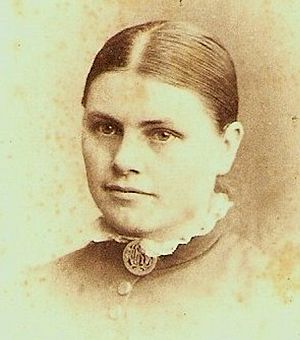Mary Adela Blagg facts for kids
Quick facts for kids
Mary Adela Blagg
|
|
|---|---|

Mary Adela Blagg as a young woman
|
|
| Born | 17 May 1858 Cheadle, Staffordshire, England
|
| Died | 14 April 1944 |
| Nationality | English |
| Occupation | astronomer |
Mary Adela Blagg (born May 17, 1858 – died April 14, 1944) was an amazing English astronomer. She made important discoveries about the Moon and stars. In 1916, she became one of the first women to join the Royal Astronomical Society, a very important group for astronomers.
Contents
Mary Blagg's Early Life and Education
Mary Blagg was born in Cheadle, Staffordshire, England. She lived in this town her whole life. Her father, John Charles Blagg, was a solicitor.
Mary was very curious and taught herself mathematics. She did this by reading her brother's school textbooks. In 1875, she went to a special school in Kensington. There, she studied algebra and the German language. Later, she volunteered as a Sunday school teacher. She also worked as a secretary for the Girls' Friendly Society.
Discovering the Universe: Mary's Journey into Astronomy
When Mary was in her middle age, she found a new passion: astronomy! She took a university course taught by Joseph Hardcastle. He was the grandson of the famous astronomer John Herschel.
Her teacher suggested she work on a special problem. This problem was about how to name features on the Moon's surface. At that time, different maps of the Moon used different names for the same features. This made it confusing for astronomers.
Standardizing Lunar Names
In 1905, a new group called the International Association of Academies asked Mary for help. They wanted her to create a complete list of all the Moon's features. This was a very long and detailed job.
She worked with another astronomer, Samuel Arthur Saunder. In 1913, they published their findings. Their work showed many differences in how lunar features were named. This helped the association decide how to fix the problem.
Studying Variable Stars
Mary also did a lot of work on variable stars. These are stars whose brightness changes over time. She worked with Professor Herbert Hall Turner on this project.
They published ten articles about variable stars in a science journal called Monthly Notices. Professor Turner said that Mary Blagg did most of the work for these articles. Because of her important contributions, Mary was elected to the British Astronomical Association in 1906.
Becoming a Fellow of the Royal Astronomical Society
Mary Blagg wrote several research papers for the Royal Astronomical Society. Because of her excellent work, she was nominated by Professor Turner. In January 1916, she was elected as a fellow of the society.
This was a very special moment! Mary was one of five women elected at the same time. They were the first women ever to become Fellows of this important society.
Mary Blagg's Work on Bode's Law
In 1913, Mary Blagg also studied something called Bode's Law. This "law" was a pattern that seemed to predict the distances of planets from the Sun. Mary used a special math method called Fourier analysis to study it.
Her research corrected a big mistake in the original Bode's Law. It also gave the law a stronger scientific basis. However, her paper was not widely known until 1953. At that time, scientists found that her predictions were correct. She had predicted the existence of new planetary moons that were not known when she published her work!
Continuing Her Lunar Work
In 1920, Mary joined the Lunar Commission of the new International Astronomical Union. They asked her to continue her work on standardizing the Moon's names.
For this task, she worked with Karl Müller. He was a retired official and an amateur astronomer. Together, they created a two-volume set in 1935. It was called Named Lunar Formations. This book became the main guide for naming features on the Moon. Later, a crater on the Moon was named Müller after Karl.
Mary Blagg's Personal Life
Mary Blagg was also a kind person who volunteered her time. During World War I, she helped care for Belgian refugee children. One of her favorite hobbies was playing chess.
People described her as a "modest and retiring" person. She rarely attended meetings, preferring to work quietly.
Honors
The crater Blagg on the Moon is named after her. This honor recognizes her important contributions to mapping and naming the Moon's surface.
See also
 In Spanish: Mary Adela Blagg para niños
In Spanish: Mary Adela Blagg para niños

